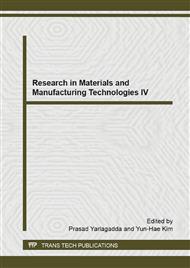[1]
X. Zhao, K. Guo, C. Zhang, Y. Ma, X. Li: Adv. Mater. Res. Vol 335-336 (2011), p.312.
Google Scholar
[2]
L. Abugoch, C. Tapia, M. Villamán, M. Yazdani-Pedram, M. Díaz-Dosque: Food Hydrocolloid. Vol 25 (2011), p.879.
DOI: 10.1016/j.foodhyd.2010.08.008
Google Scholar
[3]
X. Li, K. Guo, X. Zhao: Adv. Mater. Res. Vol 150-151 (2010), p.1396.
Google Scholar
[4]
C. Zhang, Y. Ma, X. Zhao, D. Ma: J. Food Sci. Vol 75 (2010), p. C493.
Google Scholar
[5]
H.J. Park, J.M. Bunn, P.J. Weller: Trans. ASAEVol 37 (1994), p.1281.
Google Scholar
[6]
A. Jiménez, M.J. Fabra, P. Talens, A. Chiralt: Carbohyd. Polymer. Vol 82 (2010), p.585.
Google Scholar
[7]
R.L. Wu, X.L. Wang, Y.Z. Wang, X.C. Bian, F. Li: Indust. Eng. Chem. Res. Vol 48 (2009), p.7132.
Google Scholar
[8]
P. Guerrero, K. Caba: J. Food Eng. Vol 100 (2010), p.261.
Google Scholar
[9]
G.A. Denavi, M. Pérez-Mateos, M.C. Añón, P. Montero, A.N. Mauri, M.C. Gómez-Guillén: Food Hydrocolloid. Vol 23 (2009), p. (2094).
DOI: 10.1016/j.foodhyd.2009.03.007
Google Scholar
[10]
T.H. McHugh: Food/Nahrung, Vol 44 (2000), p.148.
Google Scholar
[11]
V. Morillon, F. Debeaufort, G. Blond, M. Capelle, A. Voilley: Cri. Rev. Food Sci. Nut. Vol 42 (2002), p.67.
Google Scholar
[12]
B. Bravin, D. Peressini, A. Sensidoni: J. Food Eng. Vol 76 (2006), p.280.
Google Scholar
[13]
J. -A. Quezada Gallo, F. Debeaufort, F. Callegarin, A. Voilley: J. Membrane Sci. Vol 180 (2000), p.37.
Google Scholar
[14]
M.A. García, M.N. Martino, N.E. Zaritzky: J. Food Sci. Vol 65 (2006), p.941.
Google Scholar
[15]
C. Zhang, Y. Ma, K. Guo, X. Zhao: J. Agric. Food Chem. Vol 60 (2012), p.2219.
Google Scholar
[16]
L.H. Cheng, A. Abd Karim, C.C. Seow: Food Chem. Vol 107 (2008), p.411.
Google Scholar
[17]
D. Tapia-Blacido, A.N. Mauri, F.C. Menegalli, P.J.A. Sobral, M.C. Anon: J. Food Sci. Vol 72 (2007), p. E293.
Google Scholar
[18]
N. Diftis, V. Kiosseoglou: Food Chem. Vol 81 (2003), p.1.
Google Scholar
[19]
J. Gonzalez-Gutierrez, P. Partal, M. Garcia-Morales, C. Gallegos: Bioresource Technol. Vol 101 (2010), p. (2007).
Google Scholar
[20]
ASTM D 882-01, Annual Book of ASTM Standards, American Society for Testing and Matericals, Philadelphia, PA (2001).
Google Scholar
[21]
ASTM E 96-93, Annual Book of ASTM Standards, American Society for Testing and Matericals, Philadelphia, PA (1993).
Google Scholar
[22]
A. Jiménez, M.J. Fabra, P. Talens, A. Chiralt: Food Hydrocolloid. Vol 26 (2012), p.302.
Google Scholar
[23]
Y. Zahedi, B. Ghanbarzadeh, N. Sedaghat: J. Food Eng. Vol 100 (2009), p.102.
Google Scholar
[24]
Y. Jiang, C.H. Tang, Q.B. Wen, L. Li, X.Q. Yang: Innov. Food Sci. Emerg. Technol. Vol 8 (2007), p.218.
Google Scholar
[25]
L.C. Bertan, P.S. Tanada, A.C. Siani, C.R.F. Grosso: Food Hydrocolloid. Vol 19 (2005), p.73.
Google Scholar
[26]
L. Yang, A.T. Paulson: Food Res. Int. Vol 33 (2000), p.571.
Google Scholar


